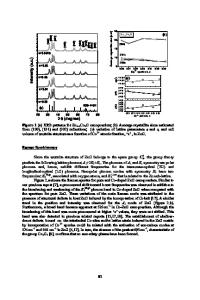Controllable Synthesis of ZnO Nanonails by Vapor-Solid Process: Growth Mechanism and Structural and Optical Properties
- PDF / 548,085 Bytes
- 8 Pages / 612 x 792 pts (letter) Page_size
- 64 Downloads / 381 Views
0957-K07-30
Controllable Synthesis of ZnO Nanonails by Vapor-Solid Process: Growth Mechanism and Structural and Optical Properties Ahmad Umar, Q. Ahsanul Haq, Sang Hoon Kim, Yeon Ho Im, and Yoon Bong Hahn Department of chemical Engineering and Technology, Chonbuk National University, Jeonju, 561-756, Korea, Republic of
ABSTRACT Single-crystalline with good optical properties aligned ZnO nanonails were grown on steel alloy substrate without the use of metal catalyst or additives by the thermal evaporation process using high purity metallic zinc powder and oxygen as source materials for zinc and oxygen, respectively. Detailed morphological studies by FESEM revealed that the obtained nanonails are grown in a high density over the whole substrate surface and are exhibiting perfect hexagonal-shaped caps. The diameters of the nanonails at their tops and bases are ranges from 120~160 nm and 50~70 nm, respectively. The detailed structural characterizations confirmed that the synthesized nanostructures are single-crystalline and grown along the c-axis direction. Raman scattering and room-temperature photoluminescence studies demonstrated the wurtzite hexagonal phase and good optical properties, respectively for the grown nanonails. INTRODUCTION Recently, one dimensional (1D) nanostructures have pulled a great attention towards itself due to their exotic, tremendous and marvelous properties in the electrical, optical, and mechanical performances as compared to their bulk materials. Due to their high surface to volume ratio and quantum confinement effect, which enhanced the materials characteristics and properties, they exhibited an extensive and unique application in various fields such as optoelectronics, electronics and catalysts, sensors, [1, 2] etc. The hexagonal wurtzite crystal structured ZnO have a great importance because of its versatility in academic as well as applications view point. Due to its wide band gap (3.37eV), high exciton binding energy (60 meV), and high mechanical and thermal stabilities, it is highly applicable in UV light emitters, varistors, transparent light power electronics [3], sensors [4], surface acoustic wave devices [5], dye sensitized oxide solar cells [6] , windows materials for displays, photocatalysts [7] etc. Interestingly, because of its non-centrosymmetric crystallographic phase, ZnO shows the piezoelectric properties which is highly useful for the fabrication of devices such as electromagnetic coupled sensors, actuators etc [8]. So far various types of ZnO nano and microstructures have been reported in the literature such as nanorods, nanowires, nanosprings and nanorings, nanostars, microtubes, nanosheet networks and hexagonal nanodiscs, flower-shaped nanostructures and so on [9-20]. In addition of these morphologies, Lao et al. presented the synthesis of ZnO nanobridges and nanonails using the mixture powders of zinc oxide, In2O3 and graphite at 1000 °C [21]. Yao et al. reported the formation of needle-like rods with a hexagonal head at 750-800 °C [22]. Shen et al. synthesized the
Data Loading...











